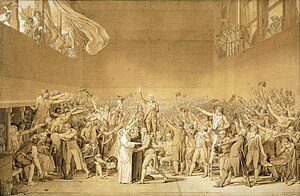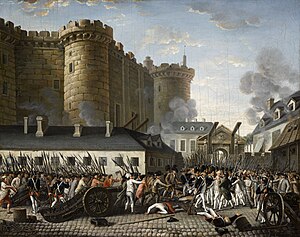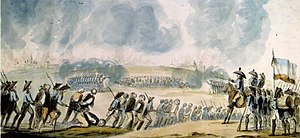Revolution and Napoleon (1789–1815)
The French Revolution
The immediate trigger for the Revolution was Louis XVI's attempts to solve the government's worsening financial situation. Recent wars, such as support of the American Revolutionary War, compounded by the loss of the North American colonies, had effectively bankrupted the state. Several years of bad harvests and an inadequate transportation system had caused rising food prices, hunger, and malnutrition; the country was further destabilized by the lower classes' increased feeling that the royal court was isolated from, and indifferent to, their hardships.
In February 1787 his finance minister, Charles Alexandre de Calonne, convened an Assembly of Notables, a group of nobles, clergy,bourgeoisie, and bureaucrats selected in order to bypass the local parliaments. This group was asked to approve a new land tax that would, for the first time, include a tax on the property of nobles and clergy. The assembly did not approve the tax, instead demanding that Louis XVI call theEstates-General.
In August 1788 the King agreed to convene theEstates-General in May 1789. While the Third Estate demanded and was granted "double representation" so as to balance the First and Second Estate, voting was to occur "by orders" – votes of the Third Estate were to be weighted – effectively canceling double representation. This eventually led to the Third Estate breaking away from the Estates-General and, joined by members of the other estates, proclaiming the creation of theNational Assembly, an assembly not of the Estates but of "the People."
In an attempt to keep control of the process and prevent the Assembly from convening, Louis XVI ordered the closure of the Salle des États where the Assembly met. After finding the door to their chamber locked and guarded, the Assembly met nearby on a tennis court and pledged the Tennis Court Oath on 20 June 1789, binding them "never to separate, and to meet wherever circumstances demand, until the constitution of the kingdom is established and affirmed on solid foundations." They were joined by some sympathetic members of the Second and First estates. After the king fired his finance minister, Jacques Necker, for giving his support and guidance to the Third Estate, worries surfaced that the legitimacy of the newly formed National Assembly might be threatened by royalists.
Paris was soon in a state of anarchy. It was consumed with riots and widespread looting. Because the royal leadership essentially abandoned the city, the mobs soon had the support of the French Guard, including arms and trained soldiers. On 14 July 1789, the insurgents set their eyes on the large weapons and ammunition cache inside the Bastille fortress, which also served as a symbol of royal tyranny. Insurgents seized the Bastille prison, killing the governor and several of his guards.
The French now celebrate 14 July each year as a symbol of the shift away from the Ancien Régime to a more modern, democratic state. Gilbert du Motier, a hero of the War of American Independence, took command of the National Guard, and the king was forced to recognize the Tricolour Cockade. Although peace was made, several nobles did not regard the new order as acceptable and emigrated in order to push the neighboring, aristocratic kingdoms to war against the new democratic regime. Because of this new period of instability, the state was struck for several weeks in July and August 1789 by the Great Fear, a period of violent class conflict.
The Declaration of the Rights of Man and Citizen was adopted by the National Assembly in August 1789 as a first step in their effort to write a constitution. Considered to be a precursor to modern international rights instruments and using the U.S. Declaration of Independence as a model, it defined a set of individual rights and collective rights of all of the estates as one. Influenced by the doctrine of natural rights, these rights were deemed universal and valid in all times and places, pertaining to human nature itself. The Assembly also replaced France's historic provinces with eighty-three departments, uniformly administered and approximately equal to one another in extent and population.
Abolition of feudalism
On 4 August 1789, the Assembly abolished feudalism, in what became known as the August Decrees, sweeping away both the seigneurial rights of the Second Estate (nobility) and the tithes gathered by the First Estate (clergy). In the course of a few hours, nobles, clergy, towns, provinces, companies, and cities lost their special privileges. The Assembly abolished the symbolic paraphernalia of the Ancien Régime – armorial bearings, liveries, etc. – which alienated the more conservative nobles. Amidst these intrigues, the Assembly continued to work on developing a constitution.
A new judicial organization made all magistracies temporary and independent of the throne. The legislators abolished hereditary offices, except for the monarchy itself. Jury trials started for criminal cases. The King would have the unique power to propose war, with the legislature then deciding whether to declare war. The Assembly abolished all internal trade barriers and suppressed guilds, masterships, and workers' organizations. Consequently, an individual could only gain the right to practice a trade through the purchase of a license, and worker strikes became illegal.
The Revolution brought about a massive shifting of powers from the Roman Catholic Church to the state. Under the Ancien Régime, the Church had been the largest landowner in the country. Legislation enacted in 1790 abolished the Church's authority to levy a tax on crops, cancelled special privileges for the clergy, and confiscated Church property. The Assembly essentially addressed the financial crisis in part by having the nation take over the property of the Church.
The republican government also enforced the Système International d'Unités (International System of Units), commissioned by Louis XVI, which became known as the Metric System. Charles-Augustin de Coulomb andAndré-Marie Ampère's works on electricity and electromagnetism were also recognised, and their units are integrated into the Metric System.
Royal family captured
When a mob from Paris attacked the royal palace at Versailles in October 1789 seeking redress for their severe poverty, the royal family was forced to move to the Tuileries Palace in Paris. Later in June 1791, the royal family secretly fled Paris in disguise for Varennes near France's northeastern border in order to seek royalist support the king believed he could trust, but they were soon discovered en route. They were brought back to Paris, after which they were essentially kept under house-arrest at the Tuileries.
Factions within the Assembly began to clarify. The opposition to revolution sat on the right-hand side of the Assembly. The "Royalist democrats" or monarchiens inclined toward organizing France along lines similar to the British constitutional model. The "National Party", representing the centre or centre-left of the assembly, represented somewhat more extreme views. The increasingly middle-class National Guard under Lafayette also slowly emerged as a power in its own right.
With most of the Assembly still favoring a constitutional monarchy rather than a republic, the various groupings reached a compromise. Under the Constitution of 1791, France would function as a constitutional monarchy with Louis XVI as little more than a figurehead. The King had to share power with the elected Legislative Assembly, although he still retained his royal veto and the ability to select ministers. He had perforce to swear an oath to the constitution, and a decree declared that retracting the oath, heading an army for the purpose of making war upon the nation, or permitting anyone to do so in his name would amount to de facto abdication.
The Legislative Assembly first met on 1 October 1791 and degenerated into chaos less than a year later. The Legislative Assembly consisted of about 165 Feuillants (constitutional monarchists) on the right, about 330Girondists (liberal republicans) in the center, a vocal group of Jacobins (radical revolutionaries) on the left, and about 250 deputies unaffiliated with any of those factions. Early on, the King vetoed legislation that threatened the émigrés with death and that decreed that every non-juring clergyman must take within eight days the civic oath mandated by the Civil Constitution of the Clergy. Over the course of a year, disagreements like this would result in a constitutional crisis, leading the Revolution to higher levels.
On the foreign affairs front, in the Declaration of Pillnitz of August 1791, Holy Roman Emperor Leopold II,Count Charles of Artois, and King Frederick William II of Prussia made Louis XVI's cause their own. These noblemen also required the Assembly to be dissolved through threats of war, but, instead of cowing the French, it infuriated them. The borders were militarised as a consequence. Under the Constitution of 1791, the solution of a constitutional monarchy was adopted, and the king supported a war against Austria in order to increase his popularity, starting the long French Revolutionary Wars. On the night of the 10 August, theJacobins, who had mainly opposed the war, suspended the monarchy. With the Prussian army entering France, more doubts were raised against the aristocracy, and these tensions climaxed during the September Massacres.
After the first great victory of the French revolutionary troops at the Battle of Valmy on 20 September 1792, the French First Republic was proclaimed the next day, on 21 September 1792. The new French Republican Calendar was then legally enforced.
Factionalism amongst revolutionaries
The National Convention was fractured into factions, the most dangerous of which became the Montagnards. The Montagnards and the Girondins were both originally Jacobins, a political club which was founded according to republican beliefs and whose members wanted a French democratic republic. The Jacobin Club, however, encountered political tension beginning in 1791 due to conflicting viewpoints in response to several revolutionary events and how to best achieve a democratic republic. Members of "The Mountain" (French: La Montagne) sided with the Parisian militants, also known as the sans-culottes, who aimed for a more repressive form of government that would institute a price maximum on essential consumer goods and would punish all traitors and enemies of the Republic.
Additionally, between war and political differences, the Montagnards believed these crises required emergency solutions. The Montagnards considered themselves the true patriots of the French Revolution. The Mountain had 302 members during its reign in 1793 and 1794, including committee members and deputies who voted with the faction. Most of its members came from the middle class and tended to represent the Parisian population. Its leaders included Maximilien Robespierre, Jean-Paul Marat, and Georges Danton. This party eventually gained overwhelming power in the Convention and governed France during the Reign of Terror.
Possibly the two most significant factors in the quarrel and consequential split between the Montagnards and the Girondins include theSeptember Massacres and the trial of Louis XVI, both in 1792. The official fall of the monarchy came on 10 August 1792 after Louis XVI refused to rescind his veto of the National Assembly's constitution. The Mountain argued for immediate execution of the king by military court-martial, insisting that he was undermining the Revolution. Because a trial would require the "presumption of innocence," such a proceeding would contradict the mission of the National Convention. The Girondins, in contrast, agreed that the king was guilty of treason but argued for his clemency and favored the option of exile or popular referendum as his sentence. However, the trial progressed and Louis XVI was executed by guillotine on 21 January 1793.
The second key factor in the split between the Montagnards and the Girondins was the September Massacres of 1792. Radical Parisians, members of the National Guard, and fédérés were angry with the poor progress in the war against Austria and Prussia and the forced enlistment of 30,000 volunteers. On 10 August, radicals went on a killing spree, slaughtering roughly 1,300 inmates in various Paris prisons, many of whom were simply common criminals, not the treasonous counterrevolutionaries condemned by the Mountain.[55] The Girondins did not tolerate the massacres, but neither the Montagnards of the Legislative Assembly nor the Paris Commune took any action to stop or condemn the killings. Members of the Girondins later accused Marat, Robespierre, and Danton as inciters of the massacres in an attempt to further their dictatorial power.
Execution of Louis XVI
When the Brunswick Manifesto of July 1792 once more threatened the French population with Austrian (Imperial) and Prussian attacks, Louis XVI was suspected of treason and taken along with his family from the Tuileries Palace in August 1792 by insurgents supported by a new revolutionary Paris Commune. The King and Queen ended up prisoners, and a rump session of the Legislative Assembly suspended the monarchy. Little more than a third of the deputies were present, almost all of them Jacobins. The King was later tried and convicted and, on 21 January 1793, was executed by the guillotine. Marie Antoinette, would follow him to the guillotine on 16 October.
What remained of a national government depended on the support of the insurrectionary Commune. When the Commune sent gangs into prisons to arbitrarily adjudicate and butcher 1400 victims, and then addressed a circular letter to the other cities of France, inviting them to follow this example, the Assembly could offer only feeble resistance. This situation persisted until a National Convention, charged with writing a new constitution, met on 20 September 1792 and became the new de facto government of France. The next day it abolished the monarchy and declared a republic.
Members of the Mountain went on to establish the Committee of Public Safety in April 1793 under Robespierre, which would be responsible for The Terror (5 September 1793 – 28 July 1794), the bloodiest and one of the most controversial phases of the French Revolution. The time between 1792 and 1794 was dominated by the ideology of the Mountain until the execution of Robespierre on 28 July 1794.
The war went badly. Prices rose, the sans-culottes (poor labourers and radical Jacobins) rioted, and counter-revolutionary activities began in some regions. This encouraged the Jacobins to seize power through a parliamentary coup, backed up by force effected by mobilising public support against the Girondist faction, and by utilising the mob power of the Parisian sans-culottes. An alliance of Jacobin and sans-culotteselements thus became the effective centre of the new government. Policy became considerably more radical.
The Reign of Terror
Starting in September 1793, a period known as the Reign of Terror ensued for approximately 12 months, the bloodiest and one of the most controversial phases of the French Revolution. The Committee of Public Safety, set up by the National Convention on 6 April 1793, formed the twelve-member de facto executive government of France. Under war conditions and with national survival seemingly at stake, the Montagnard Jacobins under Maximilien Robespierre centralized denunciations, trials, and executions. At least 18,000 people met their deaths under the guillotine or otherwise, after accusations of counter-revolutionary activities.
In 1794, Robespierre had ultra-radicals and moderate Jacobins executed. As a consequence of these actions, however, Robespierre's own popular support eroded markedly. On 27 July 1794, the Thermidorian Reaction led to the arrest and execution of Robespierre. The new government was predominantly made up of Girondists who had survived the Terror and, after taking power, they took revenge as well by banning the Jacobin Club and executing many of its former members – including Robespierre – in what was known as the White Terror.
After the stated aim of the National Convention toexport revolution, the guillotining of Louis XVI of France, and the French opening of the Scheldt, a European military coalition was formed against France. Spain, Naples, Great Britain, and the Netherlands joined Austria and Prussia in The First Coalition (1792–1797), the first major concerted effort of multiple European powers to contain Revolutionary France. It took shape after the wars had already begun.
The Republican government in Paris was radicalised after a diplomatic coup from the Jacobins said it would be the Guerre Totale ("total war") and called for a Levée en masse (mass conscription of troops). Royalist invasion forces were defeated at Toulon in 1793, leaving the French republican forces in an offensive position and granting a young officer, Napoleon Bonaparte, a certain fame. Following their victory at Fleurus, the Republicans occupied Belgium and the Rhineland. An invasion of the Netherlands established the puppetBatavian Republic. Finally, a peace agreement was concluded between France, Spain, and Prussia in 1795 at Basel.
Directory
The Convention approved a new "Constitution of the Year III" on 17 August 1795; it was ratified by a national plebiscite and took effect on 26 September 1795.[57] The new constitution created the Directory and the first bicameral legislature in French history. The parliament consisted of 500 representatives – le Conseil des Cinq-Cents (the Council of the Five Hundred) – and 250 senators – le Conseil des Anciens (the Council of Elders). Executive power went to five "directors", named annually by the Conseil des Anciens from a list submitted by le Conseil des Cinq-Cents. The nation desired rest and the healing of its many wounds. Those who wished to restore Louis XVIII and the Ancien Régime and those who would have renewed the Reign of Terror were insignificant in number. The possibility of foreign interference had vanished with the failure of the First Coalition.
The four years of the Directory were a time of arbitrary government and chronic disquiet. The late atrocities had made confidence or goodwill between the parties impossible. As the majority of French people wanted to be rid of them, they could achieve their purpose only by extraordinary means. The Convention habitually disregarded the terms of the constitution, and, when the elections went against them, resorted to the sword. They resolved to prolong the war as the best expedient for prolonging their power. They were thus driven to rely upon the armies, which also desired war and were becoming increasingly less civic in temper.
The Directory lasted until 1799 when Napoleon staged a coup and installed The Consulate. The Consulate still operated within the First Republic. The Consulate was replaced by the First Empire, established by Napoleon in 1804.






